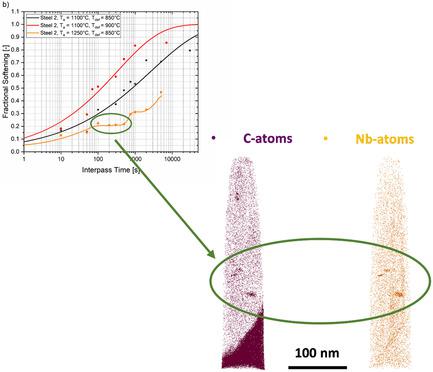当前位置:
X-MOL 学术
›
Steel Res. Int.
›
论文详情
Our official English website, www.x-mol.net, welcomes your feedback! (Note: you will need to create a separate account there.)
Influence of Microalloying Elements and Deformation Parameters on the Recrystallization and Precipitation Behavior of Two Low-Alloyed Steels
Steel Research International ( IF 2.2 ) Pub Date : 2021-03-24 , DOI: 10.1002/srin.202100065 Stefan Monschein 1 , Marlene Kapp 2, 3 , Dominik Zügner 4 , Josef Fasching 5 , Andreas Landefeld 1 , Ronald Schnitzer 1
Steel Research International ( IF 2.2 ) Pub Date : 2021-03-24 , DOI: 10.1002/srin.202100065 Stefan Monschein 1 , Marlene Kapp 2, 3 , Dominik Zügner 4 , Josef Fasching 5 , Andreas Landefeld 1 , Ronald Schnitzer 1
Affiliation

|
The alloy design of modern high-strength low-alloy (HSLA) steels aims for a well-balanced combination of high toughness and strength. Using niobium and titanium as microalloying elements together with thermomechanical processing is a common way to obtain a fine-grained microstructure and therefore enhance the strength and toughness of HSLA steels. Herein, a low-alloyed steel and a microalloyed HSLA steel are investigated in the as-rolled condition and by double-hit experiments using various deformation parameters. Atom probe tomography, scanning transmission electron microscopy inside a scanning electron microscope, transmission kikuchi diffraction, and energy-dispersive X-ray spectroscopy are used to investigate the precipitates in the as-rolled condition and after deformation. It is shown that Nb-enriched TiN precipitates with an average size of around 15 nm are responsible for grain refinement in the as-rolled condition. The annealing temperature prior to the rolling process is set below the solution temperature of Nb(C,N). Enhancing the annealing temperature in the double-hit deformation tests above the solution temperature of Nb(C,N) leads to the precipitation of fine NbC precipitates with a size of around 5 nm. These precipitates are responsible for inhibited static recrystallization behavior.
中文翻译:

微合金元素和变形参数对两种低合金钢再结晶和析出行为的影响
现代高强度低合金 (HSLA) 钢的合金设计旨在实现高韧性和强度的平衡组合。使用铌和钛作为微合金元素并进行热机械加工是获得细晶组织的常用方法,从而提高 HSLA 钢的强度和韧性。在此,低合金钢和微合金化 HSLA 钢在轧态条件下和使用各种变形参数的双击实验进行了研究。原子探针断层扫描、扫描电子显微镜内的扫描透射电子显微镜、透射菊池衍射和能量色散 X 射线光谱用于研究轧制状态和变形后的析出物。结果表明,平均尺寸约为 15 nm 的富含 Nb 的 TiN 沉淀是轧制状态下晶粒细化的原因。轧制前的退火温度设定为低于 Nb(C,N) 的固溶温度。在双击变形试验中将退火温度提高到 Nb(C,N) 的固溶温度以上会导致尺寸约为 5 nm 的细 NbC 沉淀物析出。这些沉淀是抑制静态再结晶行为的原因。N) 导致尺寸约为 5 nm 的细 NbC 沉淀物的沉淀。这些沉淀是抑制静态再结晶行为的原因。N) 导致尺寸约为 5 nm 的细 NbC 沉淀物的沉淀。这些沉淀是抑制静态再结晶行为的原因。
更新日期:2021-03-24
中文翻译:

微合金元素和变形参数对两种低合金钢再结晶和析出行为的影响
现代高强度低合金 (HSLA) 钢的合金设计旨在实现高韧性和强度的平衡组合。使用铌和钛作为微合金元素并进行热机械加工是获得细晶组织的常用方法,从而提高 HSLA 钢的强度和韧性。在此,低合金钢和微合金化 HSLA 钢在轧态条件下和使用各种变形参数的双击实验进行了研究。原子探针断层扫描、扫描电子显微镜内的扫描透射电子显微镜、透射菊池衍射和能量色散 X 射线光谱用于研究轧制状态和变形后的析出物。结果表明,平均尺寸约为 15 nm 的富含 Nb 的 TiN 沉淀是轧制状态下晶粒细化的原因。轧制前的退火温度设定为低于 Nb(C,N) 的固溶温度。在双击变形试验中将退火温度提高到 Nb(C,N) 的固溶温度以上会导致尺寸约为 5 nm 的细 NbC 沉淀物析出。这些沉淀是抑制静态再结晶行为的原因。N) 导致尺寸约为 5 nm 的细 NbC 沉淀物的沉淀。这些沉淀是抑制静态再结晶行为的原因。N) 导致尺寸约为 5 nm 的细 NbC 沉淀物的沉淀。这些沉淀是抑制静态再结晶行为的原因。



























 京公网安备 11010802027423号
京公网安备 11010802027423号